Lin S.D. Water and Wastewater Calculations Manual
Подождите немного. Документ загружается.


Wastewater Engineering 665
solution:
Step 1. Calculate volumetric BOD loading rate
Influent BOD ⫽ 143 mg/L ⫽ 143 g/m
3
⫽ 0.143 kg/m
3
⫽ 0.48 kg/(m
3
⭈ d)
Note: It is in the range of 0.3 to 0.6 kg/(m
3
⭈ d).
Step 2. Calculate F/M ratio using Eq. (6.64)
Assume MLVSS ⫽ 0.8 MLSS ⫽ 0.8 ⫻ 2600 mg/L
⫽ 2080 mg/L
⫽ 0.23 kg BOD applied/(kg MLVSS ⭈ d)
⫽ 0.23 lb BOD applied/(lb MLVSS ⭈ d)
Note: 0.2
⬍ F/M ⬍ 0.4.
Step 3. Calculate aeration time HRT
HRT ⫽ V/Q ⫽ 2260 m
3
⫼ 7570 m
3
/d
⫽ 0.30 day
⫽ 7.17 h
Note: 4 h
⬍ HRT ⬍ 8 h.
Step 4. Calculate cell residence time u
c
TSS in the aeration tank ⫽ 7570 m
3
/d ⫻ 2.6 kg/m
3
⫽ 19,682 kg/d
TSS in sludging wasting ⫽ 200 m
3
/d ⫻ 8.9 kg/m
3
⫽ 1780 kg/d
TSS in effluent ⫽ 7570 m
3
/d ⫻ 0.024 kg/m
3
⫽ 182 kg/d
⫽ 10.0 days
Note: 5 days
⬍ u
c
⬍ 15 days.
u
c
5
19,682 kg/d
1780 kg/d 1 182 kg/d
F/M 5
7570 m
3
/d 3 143 mg/L BOD applied
2260 m
3
3 2080 mg/L MLVSS
BOD load 5
amount
volume
5
7570 m
3
/d 3 0.143 kg/m
3
2260 m
3
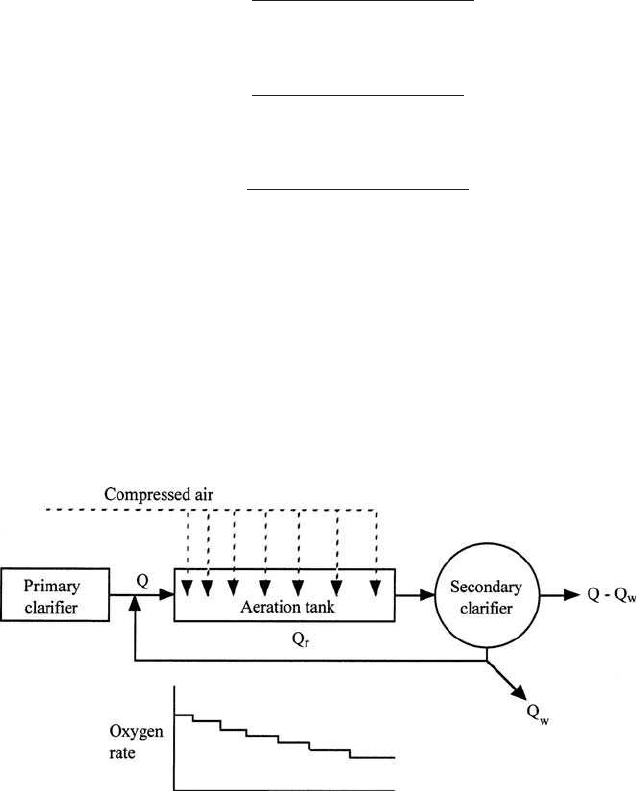
666 Chapter 6
Step 5. Calculate RAS ratio
Q
r
/Q ⫽ 3180 m
3
/d ⫼ 7570 m
3
/d
⫽ 0.42
⫽ 42%
Note: 0.25
⬍ Q
r
/Q ⬍ 0.75.
Step 6. Calculate removal efficiencies
⫽ 86%
⫽ 82%
⫽ 19%
Tapered aeration.
Since oxygen demands decrease along the length
of the plug-flow reactor, the tapered aeration process attempts to match
the oxygen supply to demand by adding more air at the influent end of
the aeration tank than at the effluent end (Fig. 6.19). This is obtained
by varying the diffuser spacing. The best results can be achieved by
supplying 55% to 75% of the total air supply to the first half of the tank
(Al-Layla et al., 1980). Advantages of tapered aeration are those of
TS 5
s513 2 418d mg/L 3 100%
513 mg/L
TSS 5
s125 2 22dmg/L 3 100%
125 mg/L
BOD 5
s143 2 20d mg/L 3 100%
143 mg/L
Figure 6.19 Conventional process with tapered aeration.
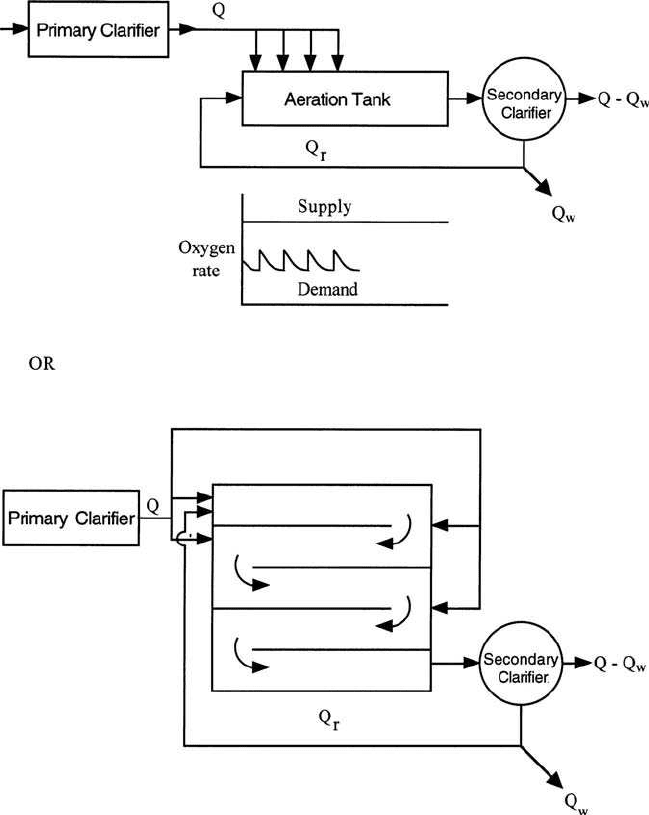
Wastewater Engineering 667
reducing below-capacity and operational costs, providing better opera-
tional control, and inhibiting nitrification if desired.
Step aeration. In step (step-feed) aeration activated-sludge systems,
the incoming wastewater is distributed to the aeration tank at a number
(3 to 4) of points along the plug-flow tank, and the return activated
sludge is introduced at the head of the aeration tank. The organic load
is distributed over the length of the tank (Fig. 6.20), thus avoiding the
Figure 6.20 Step aeration activated-sludge process.
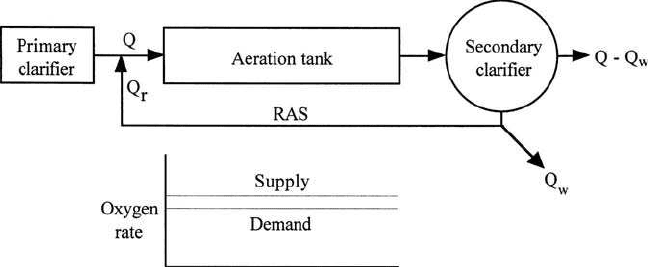
668 Chapter 6
locally lengthy oxygen demand encountered in conventional and tapered
aeration. This process leads to shorter retention time and lower acti-
vated-sludge concentrations in the mixed liquor. The process is used for
general application.
The BOD
5
loading rates are higher, 0.6 to 1.0 kg/(m
3
⭈ d) (40 to 60 lb/
(1000 ft
3
⭈ d)) and MLSS are also higher, 2000 to 3500 mg/L. The hydraulic
retention time is shorter by 3 to 5 h. The following parameters for the step
aeration process are the same as for a conventional plant: u
c
⫽ 5 to 15 days;
F/M ⫽ 0.2 to 0.4 per day; Q
r
/Q ⫽ 0.25 to 0.75; and BOD removal ⫽ 85%
to 95%.
This process, with treatment efficiency practically equivalent to that of
the conventional activated-sludge process, can be carried out in about one-
half of the aeration time while maintaining the sludge age within proper
limits of 3 to 4 days. The construction cost and the area required for step
aeration are less than for the conventional process. Operational costs are
about the same for both the conventional and step aeration processes.
Complete-mix process. Complete-mix processes disperse the influent
wastewater and return activated sludge uniformly throughout the aer-
ation tank. The shape of the reactor is not important. With careful selec-
tion of aeration and mixing equipment, the process should provide
practically complete mixing. The oxygen demand is also uniform through-
out the tank (Fig. 6.21).
Complete-mix processes protect against hydraulic and organic shock
loadings commonly encountered in the process. Toxic materials are usually
diluted below their threshold concentration. The treatment efficiency of the
complete-mix process is comparable to that of the conventional process
(85% to 95% BOD removal). The complete-mix process has increased in pop-
ularity for the treatment of industrial wastewaters. The process is used for
general application, but is susceptible to filamentous growths.
Figure 6.21 Complete-mix activated-sludge process.
Wastewater Engineering 669
The design criteria for the complete-mix process are: 0.45 to 2.0 kg
BOD
5
/(m
3
⭈ d) (28 to 125 lb/(1000 ft
3
⭈ d)), F/M ⫽ 0.2 to 0.6 per day, u
c
⫽ 5
to 15 days, MLSS ⫽ 2500 to 6500 mg/L, HRT ⫽ 3 to 5 h, Q
r
/Q ⫽ 0.25 to
1.0 (Metcalf and Eddy, Inc. 1991). A design example for the complete-mix
activated-sludge process is given in the section on mathematical modeling.
Extended aeration. The extended aeration process is a complete-mix
activated-sludge process operated at a long HRT (u ⫽ 16 to 24 or 36 h)
and a high cell residence time (sludge age u
c
⫽ 20 to 30 days). The
process may be characterized as having a long aeration time, high MLSS
concentration, high RAS pumping rate, and low sludge wastage.
Extended aeration is typically used in small plants for plant flows of
3780 m
3
/d (1 Mgal/d) or less, such as schools, villages, subdivisions,
trailer parks, etc. Many extended aeration plants are prefabricated
units or so-called package plants (Guo et al., 1981). The process is flex-
ible and is also used where nitrification is required.
The influent wastewater may be only screened and degritted without
primary sedimentation. The extended aeration system allows the plant
to operate effectively over widely varying flows and organic loadings
without upset. Organic loading rates are designed as 0.1 to 0.4 kg
BOD
5
/(m
3
⭈ d) (6 to 25 lb/(1000 ft
3
⭈ d)). The other design parameters are:
MLSS ⫽ 1500 to 5000 mg/L, and Q
r
/Q ⫽ 0.5 to 1.50 (WEF and ASCE,
1992). The extended aeration process has a food to microorganisms ratio
(F/M) from 0.05 to 0.20 kg BOD
5
per kg MLSS-day. It is developed to
minimize waste activated sludge production by providing a large endoge-
nous decay of the sludge mass. The process is so designed that the mass
of cells synthesized per day equals the mass of cells endogenous decayed
per day. Therefore there is theoretically no cell mass production.
The extended aeration process has a food to microorganism ratio from
0.05 to 0.20 kg BOD
5
per kg MLSS pre day. It is developed to minimize
waste activated sludge production by providing a large endogenous
decay of the sludge mass. The process is so designed that the mass of
cells synthesized per day equals the mass of cells endogenous decay per
day. Therefore there is theoretically no cell mass products.
Secondary clarifiers must be designed to handle the variations in
hydraulic loadings and high MLSS concentration associated with the
system. The overflow rates range from 8 to 24 m
3
/(m
2
⭈ d) (200 to 600 gal/
(d ⭈ ft
2
)) and with long retention time. Sludge may be returned to the
aeration tank through a slot opening or by an air-lift pump (Hammer,
1986). Floating materials and used sludge on the surface of the clari-
fier can be removed by a skimming device.
Since the process maintains a high concentration of microorganisms
in the aeration tank for a long time, endogenous respiration plays a
major role in activated sludge quality. More dissolved oxygen (DO) is

670 Chapter 6
required. Nitrification may occur in the system. The volatile portion
of the sludge remaining is not degraded at the same rate as normal
activated sludge and thereby results in a lower BOD exertion rate. The
effluent of extended aeration often meets BOD standards (75% to
95% removal) but does not meet TSS standards due to continuous
loss of pinpoint flocs (rising sludge). To overcome TSS loss, periodic
sludge wasting is required. It has been suggested that the average
MLSS concentration should not fall below 2000 mg/L (Guo et al.,
1981). In cold climates, heat lost in the extended aeration system
must be controlled. However, Guo et al. (1981) pointed out that insuf-
ficient staff, inadequate training, or both are the most common causes
of poor performance of the extended aeration process, especially in
small package plants.
Example: An extended aeration activated-sludge plant without sludge wast-
ing has a BOD
5
loading rate of 0.29 kg/(m
3
⭈ d) (18 lb/(1000 ft
3
⭈ d)) with aer-
ation for 24 h. The daily MLSS buildup in the aeration basin is measured as
55 mg/L. Determine the percentage of the influent BOD
5
that is converted to
MLSS and retained in the basin. Estimate the time required to increase the
MLSS from 1500 to 5500 mg/L (this range is in the design criteria).
solution:
Step 1. Calculate influent BOD concentration in mg/L
BOD ⫽ 0.29 kg/(m
3
⭈ d) ⫻ 1 day
⫽ 290 g/m
3
⫽ 290,000 mg/1000 L
⫽ 290 mg/L
Step 2. Determine the percentage
⫽ 19%
Thus 81% of the influent BOD retained in the basin
Step 3. Estimate buildup time required, t
⫽ 72.7 days
t 5
5500 mg/L 2 1500 mg/L
55 mg/sL
#
dd
MLSS buildup
influent BOD
5
55 mg/L 3 100%
290 mg/L
Wastewater Engineering 671
Short-term aeration. Short-term aeration or modified aeration is a plug-
flow pretreatment process. The process has extremely high loading rates
of 1.2 to 2.4 kg BOD
5
/(m
3
⭈ d) (75 to 150 lb/(1000 ft
3
⭈ d)) with an F/M
ratio of 1.5 to 5.0 kg BOD/d per kg MLVSS. The volumetric loadings are
low, ranging from 200 to 1000 mg/L of MLSS. The HRT (u) are 1.5 to
3 h; sludge age u
c
⫽ 0.2 to 0.5 days; and Q
r
/Q ⫽ 0.05 to 0.25. Short
retention time and low sludge age lead to a poor effluent quality and rel-
atively high solids production. This process can be used as the first
stage of a two-stage nitrification process and is used for an intermediate
degree of treatment.
The short-term aeration process offers cost savings of construction by
increasing BOD loading rates and reducing the required volume of aer-
ation tank. The process produces a relatively large amount of MLVSS
which may cause disposal problems. If the sludge is allowed to remain
in the system, the BOD
5
removal efficiency ranges from 50% to 75%
(Chermisinoff, 1995).
High rate aeration. For some cases it may not be necessary to treat the
wastewater to the high degree of effluent quality achieved by conven-
tional or other improved processes. High rate aeration is an application
of the complete-mix activated-sludge process with a short HRT (u ⫽ 0.5
to 2.0 h), a short sludge age (u
c
⫽ 5 to 10 days), a high sludge recycle
ratio (Q
r
/Q ⫽ 1.0 to 5.0), and an organic loading rate of 1.6 to 16 kg
BOD
5
/m
3
⭈ d (100 to 1000 lb/(1000 ft
3
⭈ d)). The MLSS concentration in the
aeration tanks ranges from 4000 to 10,000 mg/L, and the F/M ratios are
0.4 to 1.5 per day which are higher than those for the conventional process
(WEF and ASCE, 1991a). The process reduces the cost of construction.
Complete-mix aeration and the hydraulic thickening action of a rapid
sludge return are mandatory to offset decreased sludge settleability of
the biological flocs (Bruce and Merkens, 1973). It is designed to main-
tain the biomass in the growth phase. Poor performance of a high-rate
aeration system is usually due to insufficient aeration capacity to supply
adequate dissolved oxygen during peak loading periods. Subsequently,
suspended flocs are carried over to the secondary clarifier effluent. Also,
inadequate RAS flow rates and high solids flux may cause sludge to be
washed out through the clarifier.
Well-operated high-rate aeration processes can produce effluent qual-
ity comparable to that of a conventional plant. A BOD
5
removal efficiency
of 75% to 90% can be achieved. A high-rate single-stage aeration system
can be used for general application and to partially remove carbonaceous
BOD
5
at the first stage of a two-stage nitrification system.
Contact stabilization. The contact stabilization process or biosorption was
developed to take advantage of the adsorptive properties of activated
sludge. A schematic flow diagram of the contact stabilization system is
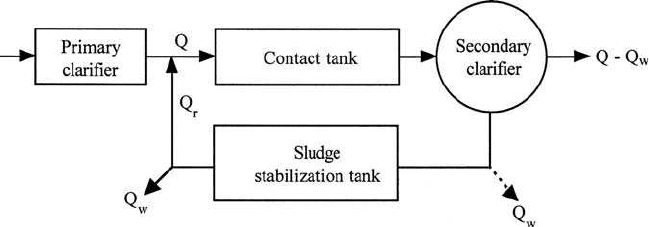
672 Chapter 6
shown in Fig. 6.22. Returned sludge which has been aerated (3 to 6 h) in
the stabilization basin (44,000 to 10,000 mg/L of MLSS) for stabilization
of previously adsorbed organic matter is mixed with influent wastewater
for a brief period (20 to 40 min). BOD removal from wastewater takes
place on immediate contact with a high concentration (1000 to 4000 mg/L
of MLSS in contact tank) of stabilized activated sludge. This adsorbs sus-
pended and colloidal solids quickly, but not dissolved organic matter.
Following the contact period, the activated sludge is separated from the
mixed liquor in a clarifier. A small portion of the sludge is wasted while
the remainder flows to the stabilization tank. During the stabilization
period, the stored organic matter is utilized for cell growth and respira-
tion; as a result, it becomes stabilized or activated again, then is recycled.
Contact stabilization was initially used to provide a partial treat-
ment (60% to 75% BOD
5
removal) at larger coastal plants. It has been
designed for package systems for industrial waste application and is
used for expansion of existing systems and package plants.
The process is a plug-flow system and is characterized by relatively
short retention times (0.5 to 3 h) with very high organic loading of 1.0
to 1.2 kg BOD
5
/(m
3
⭈ d) (62 to 75 lb/(1000 ft
3
⭈ d)). Compared to the con-
ventional activated-sludge process, oxygen requirements are lower but
waste sludge quantities are higher. Designs may either include or omit
primary treatment. In general, the process has a BOD
5
removal effi-
ciency of 80% to 90% (WEF and ASCE, 1992). This process can be effec-
tively used as the first stage of a multiple system.
The disadvantages of the process are:
1. Sensitive to variations in organic and hydraulic loadings due to its
short HRT and low MLSS concentration;
2. Neither as economical nor as efficient in BOD removal.
These shortcomings may result in noncompliance with effluent quality
standards.
Figure 6.22 Schematic flow diagram of contact stabilization process.
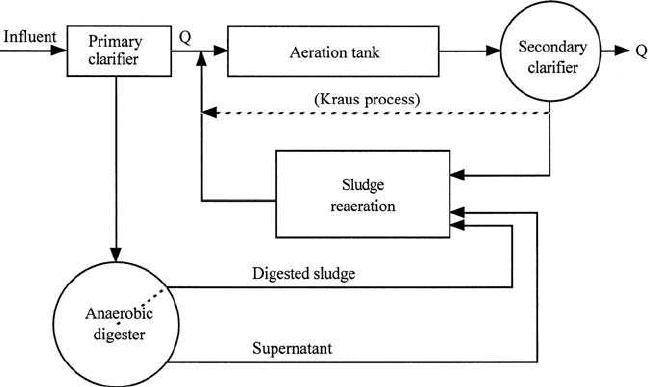
Wastewater Engineering 673
Hatfield process. The Hatfield process (developed by William Hatfield
of the Decatur Sanitary District, Illinois) differs from the contact sta-
bilization process. The process aerates anaerobic digester supernatant
or sludge (rich in nitrogen), with (all) return sludge from the secondary
clarifier then fed back to the aeration tank (Fig. 6.23). The process is
used to treat wastewater with low nitrogen levels and high carbonaceous
material levels, such as some industrial wastewaters. Supplying an aer-
obic digester effluent to the aeration tank fortifies the MLSS with amino
acids and other nitrogenous substances.
The Hatfield process has the advantage, as in the contact stabilization
system, of being able to maintain a large amount of microorganisms
under aeration in a relatively small aeration tank. Heavier types of solids
are produced in the aeration tank, which can prevent bulking problems.
However, the Hatfield process is not widely used in the United States.
Kraus process. The conventional activated-sludge plant at Peoria,
Illinois, was found to be operated improperly due to sludge bulking
because of a heavy load of carbohydrates from breweries, packing
houses, and paper mills. Kraus (1955) improved the process performance
by aerating the mixture of anaerobic digester supernatant and a small
portion of the return activated sludge in a separate aeration basin
(Fig. 6.23). Some portion of the return activated sludge bypasses the
sludge aeration basin and is introduced directly to the mixed liquor aer-
ation tank. This is a modification of the Hatfield process and lies between
the conventional system and the Hatfield process.
Figure 6.23 Schematic flow diagram of Hatfield activated-sludge process and Kraus process.
674 Chapter 6
The MLSS become highly nitrified materials which are brought into
contact with the influent wastewater in the aeration tank. The BOD
5
loading is 1.8 kg/(m
3
⭈ d) (112 lb/(1000 ft
3
⭈ d)) with 90% removal.
The specific gravity of the digester solids is greater than that of the
activated sludge, and the settling characteristics are thus improved.
Since high dissolved oxygen is required for the Kraus process, in order
to cope with high oxygen demand, Kraus applied a dual system in the
sludge reaeration basin in which there was a combination of coarse-
bubble aeration at the top of the basin and fine-bubble aeration at the
bottom of the basin. The process is used for high-strength wastewaters
with low nitrogen levels.
The design criteria for the Kraus process are: BOD
5
loading ⫽ 0.6 to 1.6
kg/(m
3
⭈ d) (40 to 100 lb/(1000 ft
3
⭈ d)), F/M ⫽ 0.3 to 0.8 per day, MLSS ⫽
2000 to 3000 mg/L, HRT ⫽ 4 to 8 days, Q
r
/Q ⫽ 0.5 to 1.0.
Sequencing batch reactor. A sequencing batch reactor (SBR) is a peri-
odically operated, fill-and-draw activated-sludge system. The unit
process used in the SBR and the conventional activated-sludge system
are essentially the same. Both have aeration and sedimentation. In the
activated-sludge plant, the processes are taking place simultaneously
in separate basins, whereas in the SBR the aeration and clarification
processes are carried out sequentially in the same basin. The system is
used for small communities with limited land.
Each reactor in an SBR system has five discrete periods (steps) in each
cycle: fill, react (aeration), settle (sedimentation/clarification), draw
(decant), and idle (Herzbrun et al., 1985). Biological activities are
initiated as the influent wastewater fills the basin. During the fill and
react period, the wastewater is aerated in the same manner as in a
conventional activated-sludge system. After the reaction step, the mixed
liquor suspended solids are allowed to settle in the same basin. The
treated supernatant is withdrawn during the draw period. The idle
period, the time between the draw and fill, may be zero or some certain
period (days). The process is flexible and can remove nitrogen and phos-
phorus. Since the development of SBR technology in the early 1960s, a
number of process modifications have been made to achieve specific
treatment objectives.
In an SBR operation, sludge wasting is an important task relating to
system performance. It usually takes place during the settle and idle
phases. There is no return activated-sludge system in the SBR system.
High-purity oxygen system. The pure oxygen activated-sludge process
was first studied by Okun in 1947 (Okun, 1949). The process achieved
commercial status in the 1970s. Currently a large number of high-purity
oxygen activated-sludge plants have been put into operation.
